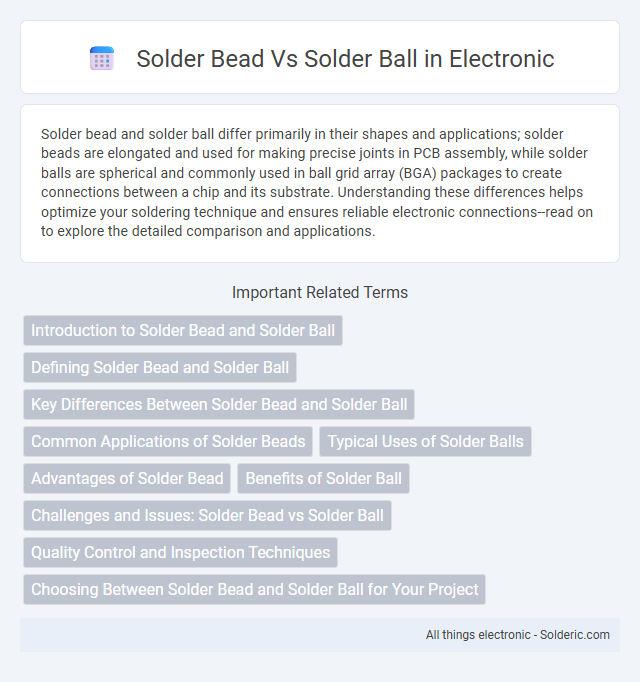Solder bead and solder ball differ primarily in their shapes and applications; solder beads are elongated and used for making precise joints in PCB assembly, while solder balls are spherical and commonly used in ball grid array (BGA) packages to create connections between a chip and its substrate. Understanding these differences helps optimize your soldering technique and ensures reliable electronic connections--read on to explore the detailed comparison and applications.
Comparison Table
| Feature | Solder Bead | Solder Ball |
|---|---|---|
| Definition | Small globules of solder applied manually or by wave soldering | Pre-formed spherical solder used mainly in Ball Grid Array (BGA) applications |
| Shape | Irregular, blob-like | Precisely spherical |
| Application | General PCB repairs, wire connections, and small solder joints | Surface mount technology, especially in BGA packages for chip connections |
| Placement Method | Manually applied or wave soldering | Machine placed with high precision during PCB assembly |
| Size Control | Less uniform, varies by application | Consistent size for reliable electrical and mechanical connection |
| Typical Materials | Tin-lead, lead-free alloys | Lead-free alloys preferred for modern electronics |
| Use Case | Repairs, prototyping, simple solder joints | High-density interconnects, advanced semiconductor packaging |
Introduction to Solder Bead and Solder Ball
Solder bead and solder ball are essential components in electronics soldering, designed to create secure electrical connections. A solder bead is a small, elongated drop of solder used to join two surfaces, offering controlled flow and precise placement during assembly. Solder balls, typically spherical and of uniform size, are commonly employed in Ball Grid Array (BGA) packaging for creating reliable connections between integrated circuits and printed circuit boards.
Defining Solder Bead and Solder Ball
Solder bead refers to a small, compact mass of molten solder that solidifies on a joint to create a reliable electrical and mechanical connection. Solder ball is a tiny spherical droplet of solder commonly used in surface mount technology for precise component attachment and reflow soldering processes. Understanding the differences between solder bead and solder ball helps you choose the right solder form for improving joint strength and circuit performance.
Key Differences Between Solder Bead and Solder Ball
Solder beads are pre-formed small cylinders or pellets of solder used primarily for manual soldering and repairs, while solder balls are tiny spherical solder particles commonly utilized in Ball Grid Array (BGA) applications for automated PCB assembly. Solder beads typically offer easier handling and are suitable for selective soldering, whereas solder balls ensure precise, uniform connections in high-density electronic packaging. The key differences lie in their shape, application methods, and usage contexts within electronics manufacturing.
Common Applications of Solder Beads
Solder beads are extensively used in electronic manufacturing for creating reliable connections in printed circuit boards (PCBs), particularly in surface-mount technology (SMT) and through-hole assembly processes. Their precise size and shape make them ideal for fine-pitch components, enhancing solder joint consistency and reducing defects in consumer electronics, automotive control units, and medical devices. When selecting between solder bead and solder ball options, understanding your application's thermal and mechanical requirements ensures optimal solder joint performance.
Typical Uses of Solder Balls
Solder balls are primarily used in Ball Grid Array (BGA) packaging to establish electrical connections between semiconductor devices and printed circuit boards (PCBs). Their precise size and placement enable reliable, high-density interconnections crucial for advanced electronics such as smartphones, computers, and gaming consoles. You can expect solder balls to ensure strong mechanical bonds and efficient signal transmission in complex assembly processes.
Advantages of Solder Bead
Solder beads offer improved control during the soldering process compared to solder balls, resulting in more precise and reliable joints. Their consistent shape and size enhance automated assembly line efficiency, reducing defects and rework. Choosing solder beads for your manufacturing ensures better thermal conductivity and mechanical strength in electronic connections.
Benefits of Solder Ball
Solder balls offer precise placement and consistent size, enhancing reliable electrical connections in microelectronics assembly. Their uniform shape improves reflow soldering efficiency, reducing defects such as bridging or voids. The use of solder balls supports miniaturization and high-density packaging, critical for advanced semiconductor devices.
Challenges and Issues: Solder Bead vs Solder Ball
Solder beads often present challenges related to inconsistent size and shape, leading to difficulties in achieving reliable electrical connections and potential solder bridging. Solder balls, while generally more uniform, can face issues such as oxidation or contamination during handling, impacting joint quality and mechanical strength. Both solder bead and solder ball processes require precise temperature control and flux application to prevent defects like voids, insufficient wetting, or tombstoning in surface mount technology (SMT) assemblies.
Quality Control and Inspection Techniques
Solder bead and solder ball quality control relies heavily on precise inspection techniques such as X-ray imaging and automated optical inspection (AOI) to detect defects like voids, misalignment, or incomplete fusion. Solder balls typically require stricter inspection protocols due to their critical role in Ball Grid Array (BGA) packaging, where uniformity and reliability directly affect electrical performance. Your production process benefits from statistical process control (SPC) and real-time monitoring to ensure consistent solder joint integrity and minimize failure rates.
Choosing Between Solder Bead and Solder Ball for Your Project
Choosing between solder bead and solder ball depends on the specific application requirements and assembly process. Solder beads offer better control in manual soldering tasks, enabling precise application for rework or small-scale projects. Solder balls, commonly used in Ball Grid Array (BGA) packaging, provide uniform solder distribution and reliable electrical connections in automated surface-mount technology (SMT) production lines.
Solder bead vs solder ball Infographic

 solderic.com
solderic.com